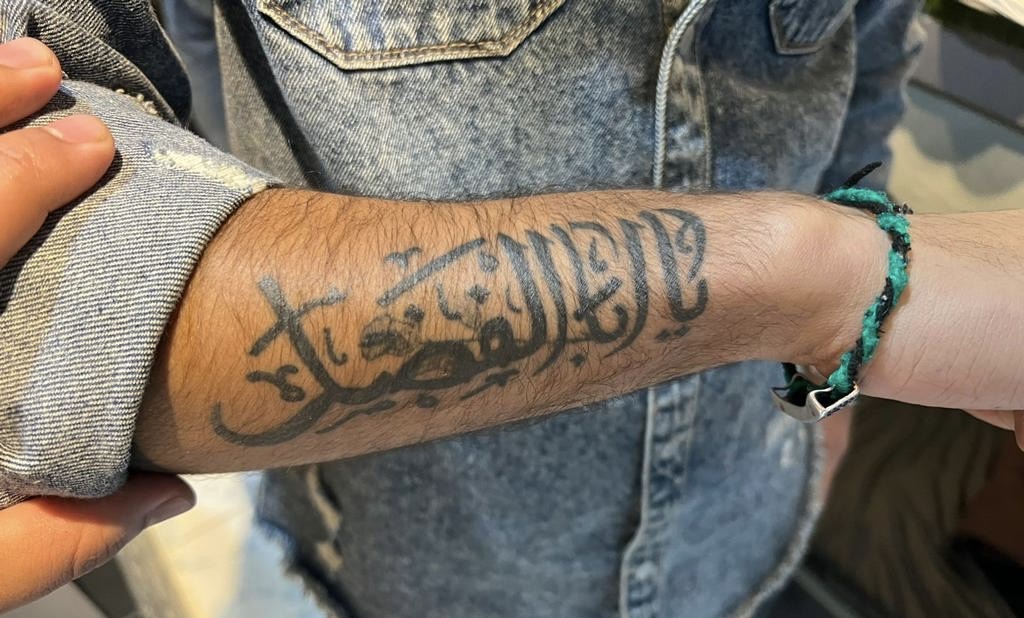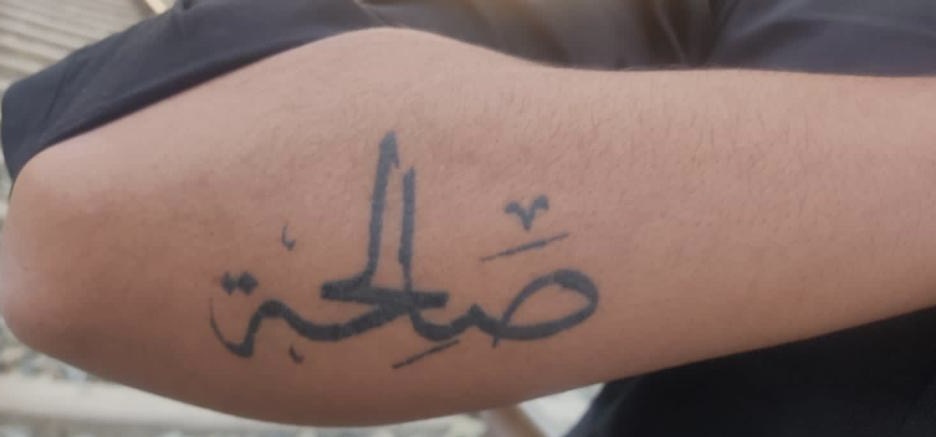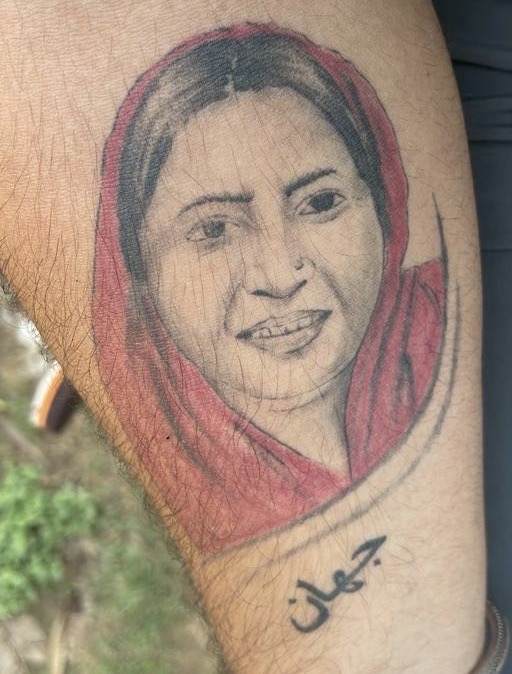For ages, people have been undergoing a very painful process of engraving symbolic memories for the sake of their beliefs, love and life lessons. As professional tattoo studios came in, wearing one’s heart on the sleeves became a new fashion statement. The trend is changing. Now the youth are rushing in hoards to remove tattoos for reasons of faith, health, jobs and a stable friction-free conjugal life, Khalid Bashir Gura reports

“I remember a case wherein a person got his tattoo removed from an unqualified person who had convinced the patient to undergo the procedure by citing a fancy term “plasma ionisation,” narrates Dr Faizan, lecturer and a consultant dermatologist at SKIMS, Medical College. Ideally, it is not the correct method for tattoo removal.
It, the doctor said means burning the skin with a medical device to remove the tattoo along with the affected skin. “The patient ended up having sepsis and landed in hospital emergency and could only be saved with great efforts by the medical team.”
Inking Dreams
Five years ago, T, now 21, was sitting with his friend. Then a teenager, he saw a fresh tattoo on his friend’s arm which appealed to him. Curious, he enquired about the process of getting it engraved but was disappointed as there was no professional studio. Unlike now, tattoos and professional studios according to him were not in vogue in Kashmir.
His parents were fuming once they discovered a tattoo on his wrist, which also dented people’s perception of him as a ‘good boy.’ Like the world over, even in Kashmir, people carrying engraving on their bodies are seen as abnormal and deviant. The process of sketching tattoos at that time was painful and taboo, he believes. Now the story is changing.
“We used gel pens to make tattoos and needles. Firstly we would imprint the design with pen and then prick it with a needle,” he said. Gradually the ink would seep into engraved pricks. As the blood would ooze out of pricks, they used waterproof ink so that the imprinted design would not be smudged. The blood flowed while the water-proof ink remained in pores which after healing became tattoo.
Tattoos are not new to Kashmir according to people involved in the process of making and removing tattoos. Some of our elders still carry a green impression of their name, moon, and crescent on their hands or arms. But social media has enabled access and acceptance now as they flaunt varied designs of their influencers, especially from the music and sports world.
The New Trend
Tattoos are stories too. They are a window to peoples’ beliefs, soul, culture, memories, and psyche. Tattooing the skin as a means of personal expression is a ritualised practice that has been around for centuries across many different cultures.
“It is giving voice to one’s abstract thoughts,” said T. “Every individual has their reasons for engraving it. Some get inked in peer pressure to gain social acceptance, or a personal desire to appear like their idol, or to deal with past or engrave future hope or immortalise memories.” According to him, many of his friends engraved symbolic dates of joy and grief. “I still carry my name and a trail of stars on my wrist.
However, many of his friends have imprinted tattoos of international footballers, Punjabi music celebrities, rap singers and cricketers as they dream someday to be like their idols.
Many people in the 16-25 age groups, according to tattoo makers and removers have sketched tattoos of their beloved’s names and hearts or initials of their names in teenage to immortalise relationships.
Similarly, Sehrish at the age of 18, got a tattoo on her wrist. Like her friends, she also did not want to feel left out.
“I sketched a tattoo of a heart and name with red and blue ink. I got a tattoo from a professional studio in Kashmir. It was a little painful as my skin reacted to ink and got allergic,” she said. “The pain soon subsided.” She, however, insisted that she was not influenced by any celebrity. “It was personal”.
As youth get influenced in online and offline mode, in 2018, Sahil, a teenager, accompanied his friend to a shop to get his fading tattoo renewed. “I felt tempted in the dark, small, shop of a tattoo maker in Lal Chowk. He showed me different designs on the computer. It involved multiple rounds. However, it was a permanent tattoo,” he said but to avert the anger of his family he told them it was a temporary one.
According to him, to combat his inhibitions and conscience crisis due to societal, and religious prisms to get tattooed, his friend motivated him. “Many of my friends have tattoos of knives, swords, the name of Allah and the last Prophet including symbols, which entail religious significance engraved on their necks, arms, and wrists,” he said. However, he admitted the shopkeeper was not professional but there was no other option.
As the process started, Sahil said the pain was bearable. Before getting tattooed he removed hair from his arm. The design print was imprinted on his arm and later multiple inks of varied colours were used to make a tattoo of his choice.

Tattoo Maker
Mubashir Bashir Beigh, who has a sophisticated studio in Srinagar attracts a multitude of customers of different age groups and places across Kashmir. As his followers on social media run thousands, he claims to be the first professional tattoo artist in Kashmir.
Beigh caters to requests for carving a wide range of images and symbols depending on individual choice. Mostly he draws star images of popular sportspersons and even an impression of a lion, tiger, and flowers on arms.
“There are tattoos on varied themes. Some engrave trendy tattoos, some name of their beloved, some parents, or some inscribe story of life,” Mubashir said. Tattoos are sacrosanct to individuals as they embody deep meanings and commitment to any cause and belief. “We do not sketch tattoos if the age of a customer is below 18 and if someone wants they need consent form and parents approval.”
Personally, Mubashir got himself tattooed in Delhi. As he began applying them to his friends and uploaded his work on social media, he saw a surge in demand, as youth, and even tourists wanted to sketch tattoos.
Even though he teaches as well as practices art in Kashmir, he recalls that he has had to do courses related to it. Later, Mubashir worked in Mumbai, Delhi, and Punjab to hone his skills.
In Kashmir, Mubashir said tattooing was not an organised affair as people did it on their own in an unhygienic and unprofessional way. He believes he contributed to making it clean, professional and an organised affair.
Tattoo Types
There are different types of tattoos like fine lines, portraits, geometrics, surrealism, and realism. “Most of the people sketch Islamic tattoos in Kashmir,” he said. “Similarly, there are two kinds, permanent and temporary. But in permanent one has to take care of hygiene, inks, needles and other qualitative equipment,” according to him as there are many colours in inks. “There are Ultraviolet (UV) inks which are visible only in UV light,” he said.
Mubashir believes that tattoos are not harmful if hygienically done by a professional. “However, most people get tattooed by unprofessional, especially on roadsides outside Kashmir. They may be cheap but can be risky health-wise,” he said as the ink is not tested and organic.
On average, he caters to at least 30 local customers mostly males.
Removal
Off late, the trend of tattoo removal across age and gender has picked up, especially in the month of Ramadan, the Muslim month of fasting. “I started tattoo removal free for the elderly and made a discount for youth,” Dr Burhan who has a fellowship in Aesthetic Laser, said. “Every day I would cater to around 10 customers and would charge a minimum of Rs 300 for a single session.”
As tattoo removal is coinciding with the growing trend of tattooing, there is a conscience crisis it entails. A month ago, Basit Basheer, at Karanagar started removing tattoos for free.
“I thought the cost of removal is high and facilitate ease to remove it,” as people according to tattoo removers are mostly driven by religious beliefs to get them removed. The customers at his shop had come from far-off places to remove tattoos and get rid of sins or something that rendered them unfit for ablution and prayers according to them. T who could not afford to pay for many sessions of tattoo removal availed services of Basit as he wants to get rid of his tattoo.
Sehrish, too got her tattoo removed from Dr Burhan at the cost of Rs 500 per session as the rates vary as per ink and size of the tattoo. She decided to remove the tattoo after the realisation dawned on her that it was not permitted by faith. “I could not carry the burden,” she said.
Free Tattoo Removal?
Mubashir believes that it is a business strategy adopted by people to promote other services at their shops while disguising tattoo laser removal as free. “I also remove tattoos but I charge. I charge a maximum of Rs 2000. The free service providers do not do it effectively and their incompetency may cost a patient his life,” he said.
There are certain job sectors which do not recruit candidates with tattooed bodies. This according to Dr Shah Aaqib Aslam, a dermatologist at SKIMS, Medical College, has encountered cases that were in a hurry to remove tattoos in a week, unlike lasers which take months. “So we had to scrap that part of the skin”, he said.

However, much to the reprieve of many, CAPF candidates, the Jammu and Kashmir and Ladakh High Court early this year, observed that mere abraded lesions on the hand and forearm, which do not have any potential to interfere with the working of a constable cannot be made a ground to declare a candidate unfit for service.
Undoing the Indelibility
“I was in a relationship four years ago. I decided to immortalise my love. I engraved my boyfriend’s name on my wrist,” Sehrish, 18, (name changed) said. The relationship, however, saw its roller-coaster ride and could not survive. She was depressed and the tattoo served as a constant reminder of him. “There was a moment when I wanted to commit suicide. But, then I came across a tattoo remover professional. I went to the studio and erased his name on my wrist which had shacked me to my past. Suddenly, after removing it, I felt psychologically better to move on with my life.”
Similarly, another boy, 26, a few years ago, shares the same story after relationship failure. “I had sketched a tattoo in my girlfriend’s memory but after break up whenever I saw it, I was hurt. It was a burden and mental torture. I wanted to forget her,” he said. According to him, after removing it, he believes he has been set free from her memories.
Dermatology and Tattoos
Even though tattoos have been present in the elderly generation for many decades, people mostly come to hospitals to remove tattoos. “We do not see them as patients, hence there is no record of many we cater to,” the doctor said. “They are individuals who have done tattoos on their body and now want to get rid of them.”
According to Dr Aslam, there is a footfall of two groups: the elderly and younger generation both want to remove tattoos primarily due to religious awareness that it is not permissible in Islam.
Similarly, individuals in the age group of 16-25 mostly were influenced by social media or peers and wanted to get rid of these tattoos. “Most of them are accompanied by parents. There is another factor which compels them to remove tattoos is less cultural acceptance and stereotyping associated with it,” he said. “There are many people who as they are getting married want to get rid of tattoos especially one involving letters, images engraved of beloved; a reminder of jilted love or failed relationship or something that may hinder prospects of a future relationship.”
Risks
According to Dr Aslam, tattooing is a process and he questioned whether it is done with sterile equipment and a hygienic environment while following proper safety protocols. “Are those who are getting themselves tattooed aware that this can even spread infections like HIV and hepatitis? Are parlours ensuring this safety? Secondly, are the colour agents inks used organic or not,” he said.
As he explained the process of removing, he said it involves the type of ink to design to the size of a tattoo. “Removing tattoo by laser is a non-invasive process but it requires expertise,” he said as removing by laser is a better option as it leaves no scars and is less painful.
The dermatologist questioned the removal of tattoos for free and questioned the efficacy and qualifications of those who remove it as he termed tattoo removal a science.
“Once someone decides to remove tattoos it becomes a medical thing,” the doctor said. “After assessing the kind and type of tattoo, the doctor or expert remover may take a call to remove it either by laser or by exorcising that part of the skin.”
According to him, the process of removal should be done cautiously. The room should be absorbent of laser rays and the eyes of patients should be covered as it can create cataracts in the eyes. Laser should not be done in pregnant women. “I have seen many videos where enough precautionary measures were not taken. The eyes of patients in many videos were exposed. Many people had contracted infections during removal processes through damaged skin,” Dr Aslam said.
Dr Faizan said people also use acids, incense sticks and other household items to burn the tattoo and the skin. “Not only are these methods associated with very deep and ugly scars, they can also cause very serious side effects like local infections and in some cases severe blood infection or sepsis,” he said.
There are cases of wide tattoo removal where laser was done by a quack resulting in post-laser burn and sepsis and atrophic scary according to Dr Aqib.
People who find it unaffordable to pay to get their tattoos removed by professionals should go to hospitals like SMHS and JVC, Bemina, the health facilities which have sophisticated equipment for tattoo removal. Similarly, according to a doctor, someone who wants to get rid of tattoos should visit government-approved dermatology centres where a technician is doing it under the supervision of a doctor.
“When it is not done under the supervision of a doctor by a technician, there are side effects,” he said as different colours require different wavelengths.
Battling for Life
A week after engraving a tattoo on his arm, a 23-year-old boy is battling for his life in ICU for 17 days at SMHS. After developing an infection, he went to the hospital for treatment and was instantly admitted. His wound was badly infected revealed a source privy to the case.
“He developed sepsis, which was further investigated and revealed atypical pneumonia with the tattoo site being the septic focus. The plastic surgery team have removed the infected part of his skin,” the source revealed. A son of a daily wage labourer, it has incurred the cost of lakhs of rupees as his family availed the help of one of the NGOs of Kashmir.
The post Undoing the Indelibility appeared first on Kashmir Life.
from Kashmir Life https://ift.tt/3usyv1t
via IFTTThttps://ift.tt/M2T3cmL
No comments:
Post a Comment